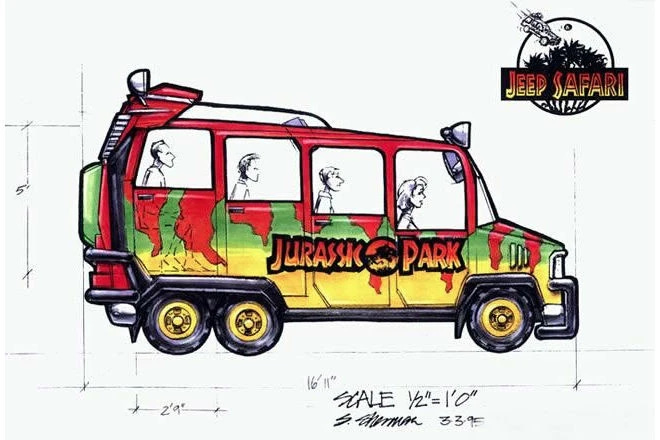Universal Almost Built the Greatest Jurassic Park Ride Ever. Then It Vanished.
They planned raptor ambushes, T-Rex attacks, and real jeep chaos — then pulled the plug. Here's why this lost ride still haunts Islands of Adventure.
Universal’s original plan for Islands of Adventure was a bold pivot from Cartoon World to cinematic immersion, and among its lineup of ambitious Jurassic Park rides was the Jeep Safari. Guests would have boarded life-sized Ford Explorer-style tour jeeps, embarking on a self-guided journey that promised awe, adventure, and panic-packed encounters. But decades later, that ride remains a tantalizing “what if” beneath the park’s jungle canopy.
The story began back in the late 1990s when Universal saw an opportunity to leverage the cinematic thrill of its blockbuster franchise. Jeep Safari was designed to be more than a ride—it was to be an expedition. Vehicles would pass under the iconic Jurassic Park entrance, glide beneath a towering Brachiosaurus and circle a tranquil lagoon. That quiet prelude would make the chaos all the more real.
According to multiple sources—including Orlando ParkStop and Jurassic Park Wiki—the ride’s structure mimicked key sequences from Spielberg’s 1993 film, with suspense built around elements such as a dead-end blocked by a predatory dinosaur and a reverse escape into a raptor den (Orlando ParkStop; Jurassic Park Wiki; Storybook Amusement).
In the envisioned climax, riders experience a nerve-jangling transition: the jeep becomes trapped, soldiers raptors swarm the roof, and the vehicle careens onto a swinging bridge before culminating in a T-Rex showdown. Early animatics show the jeep possibly rated to pitch side-to-side as the colossal predator stomps overhead—a moment of physical theater that no simulator could replicate (ScreenCrush; Orlando ParkStop).
Visually, concept art confirmed riders would face both indoor gloom and outdoor light—effects testing immersion previously unseen in Orlando. The ride promised reversed motion, unexpected dents, violent jolts, and dramatic use of animatronic scale. One fan-commenting blog called it “the ride we saw in our dreams after watching Jurassic Park” (Storybook Amusement).
If Jeep Safari sounds familiar, it’s because it played like a dramatic remix of Jurassic Park River Adventure. Both opened with scenic tranquility, built toward a chase, inserted velociraptors, then ended in a heart-pounding T-Rex confrontation. Universal ultimately decided the water ride was more feasible, cheaper to run, and less complex. Jeep Safari would have demanded advanced vehicle mechanics, specialized track systems, and reverse-motion technologies—all before factoring in the massive animatronic investment (Storybook Amusement; Jurassic Park Wiki).
Cost was another concern. River Adventure already cost over $100 million at build—Jeep Safari's bill likely would have pushed Universal's budget well past what they'd allocated for the Jurassic section. When Cartoon World fell apart, the park needed winners. And River Adventure was the perfect signature anchor.
Jeep Safari had real estate commitments. A dedicated expansion pad sat behind the Thunder Falls Terrace restaurant, later claimed by Skull Island: Reign of Kong (AllEars; Orlando ParkStop). Guests entering from Toon Lagoon might have zipped past towering fern groves, only to hear distant roars from Jurassic Park’s gate—but instead they met Kong.
That unused parcel underscores a park built with potential in mind—a readiness to add cinematic zones as IP and budget aligned. But Jeep Safari’s mechanics and narrative overlap sealed its fate.
Today, fans argue Jeep Safari would have deepened Jurassic Park’s experimental scope in Orlando. It “would have been incredible,” one Reddit thread concluded, praising its physicality and immersion (Reddit). Imagine a physical journey where animatronics, mechanical shifts, and environmental design all work in concert. Universal chose the safe bet—and the gift of hindsight reminds us Jeep Safari might have been extraordinary.
But parks are complex beasts. One extra land or mixed-use area has ripple effects: maintenance, walkthrough traffic, operational training, capacity. Universal had to prioritize, and they bet on versatility and reliability. River Adventure let them field-test groundbreaking robotics mass-deployment; Jeep Safari probably would have been a maintenance nightmare.
Jeep Safari’s concept art lives on in fan albums and pitch retrospectives, influencing other parks and dark-ride designs. Every failed theme-park blueprint carries lessons. Ride designers may still mine Jeep Safari for pacing, tension, hybrid indoor-outdoor structure, and the art of a good dinosaur ambush. It shaped what could have been, and what should never be abandoned in whiteboard sessions.
So why does Jeep Safari still matter? Because it reminds us how close amusement design came to melding physical unpredictability with intellectual property in deeply embodied ways. It dared to imagine a ride where guests controlled their trajectory—and that interactivity would have challenged the queasy notion that rides dance to a two-minute choreography.
Today, Islands of Adventure has River Adventure, VelociCoaster, and Reign of Kong—rides great in their ways—but none with the bold refusal to hold rider agency and movie-accurate paranoia in tension. Jeep Safari remains a fascinating "what if" and a blueprint for hybrid-vehicle experiences we haven’t yet seen in mass deployment.
If Universal ever decides to eclipse nostalgia for transport innovation, Jeep Safari is the ghost in the machine they can revisit. For now, it remains a Jurassic legend whispered by construction crews and concept-art hunters, and an unbuilt dream that may yet inspire tomorrow’s theme-park revolutions.






